Sichuan pepper is well-known to good chefs and fine gourmets, but what is less known is that in Laos there is a very similar species, which is much sought after, even in China. Both these peppers, of Laos and China, are Zanthoxylum, and belong to the Rutaceae family which comprises a number of highly aromatic plants including the Citrus; the different species of this genre are not always well identified, they are found in the world’s hot climates, and all the Asian species, contrary to those of America and Africa, are used in cooking.
The « Lao pepper », mak khène, strongly resembles its Chinese neighbour and it has all its properties although its taste is a little different. It is found growing wild, but it can also be cultivated. As a spice, it is used less than in the neighbouring region of Yunnan, but its uses are more varied. The fruit pods are crunched and blended with meat or fish; cracked and roasted, they are put in certain spicy sauces. The young leaves are also served as a condiment or vegetable.
In traditional medicine, mak khène has the reputation for treating goitres, but it is also currently used as an oral anaesthetic. Moreover, it is used as an ingredient in certain modern toothpastes. The leaves are among those that enable the making of rice wine. Finally, and for a lengthy period of time, this yellowish wood (that is the meaning of zanthoxylum) continues to be used in the making of tool handles, sword sheaths, and statues.
These diverse uses make mak khène very appreciated by the domestic market and sought after by our neighbours, the Chinese in particular, who import more and more of it. The easy harvesting of this fruit condiment constitutes a considerable supply to the economy of numerous villages in northern Laos. Sadly, this same ease of harvesting is leading to the depletion of this plant in its natural state and its farming is now encouraged by the Lao government.
Le Poivre du Sichuan est bien connu des bons cuisiniers et des fins gourmets, mais ce que l’on sait moins c’est que pousse au Laos une espèce très proche, très recherchée dans la région jusqu’en Chine même. Ces poivres, celui du Laos et celui de Chine, sont des Zanthoxylum, ils appartiennent à la famille des Rutacées qui englobe nombre de plantes très aromatiques dont les Citrus; les différentes espèces de ce genre ne sont pas toujours bien identifiées, elles se retrouvent toutes dans les régions chaudes du Globe et toutes les espèces asiatiques, au contraire des espèces américaines et africaines sont utilisées en cuisine.
« Le poivre du Laos », mak khène, ressemble fort à son voisin chinois et il en a toutes les propriétés avec, toutefois, une saveur un peu différente. On le trouve à l’état sauvage mais il pourrait aussi être cultivé. Comme épice on l’emploie moins que dans la région voisine du Yunnan mais ses utilisations sont plus variées. Les cosses du fruit sont croquées en accompagnement de viande ou de poisson; grillées et pilées on les met dans certaines sauces pimentées. Les jeunes feuilles sont également employées comme condiment ou légume.
En médecine traditionnelle, mak khène a la réputation de soigner le goitre, mais on l’emploie aussi couramment comme anesthésique buccal; d’ailleurs il entre dans la composition de certains dentifrices modernes. Les feuilles font partie des plantes qui permettent la fabrication de l’alcool de riz. Enfin avec le bois jaunâtre (c’est le sens de zanthoxylum) et d’une durée assez longue on fait des manches d’outils, des fourreaux de sabre, des statuettes.
Ces divers usages font que mak khène est très apprécié sur le marché intérieur et recherché par nos voisins en particulier les Chinois qui en importent de plus en plus. La récolte facile de ce fruit-condiment constitue un apport très appréciable à l’économie de nombreux villages du Nord Laos. Malheureusement cette facilité même conduit à la raréfaction de la plante à l’état naturel et sa culture est désormais encouragée par le gouvernement lao.
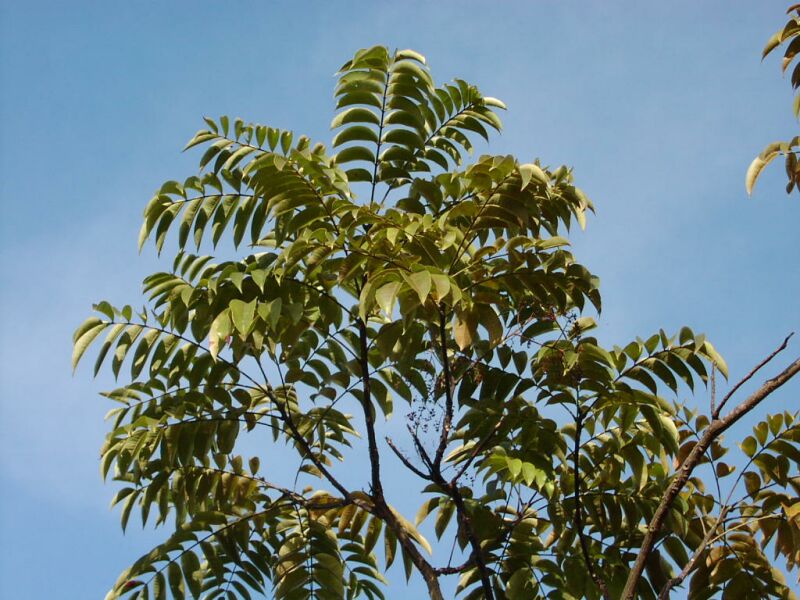
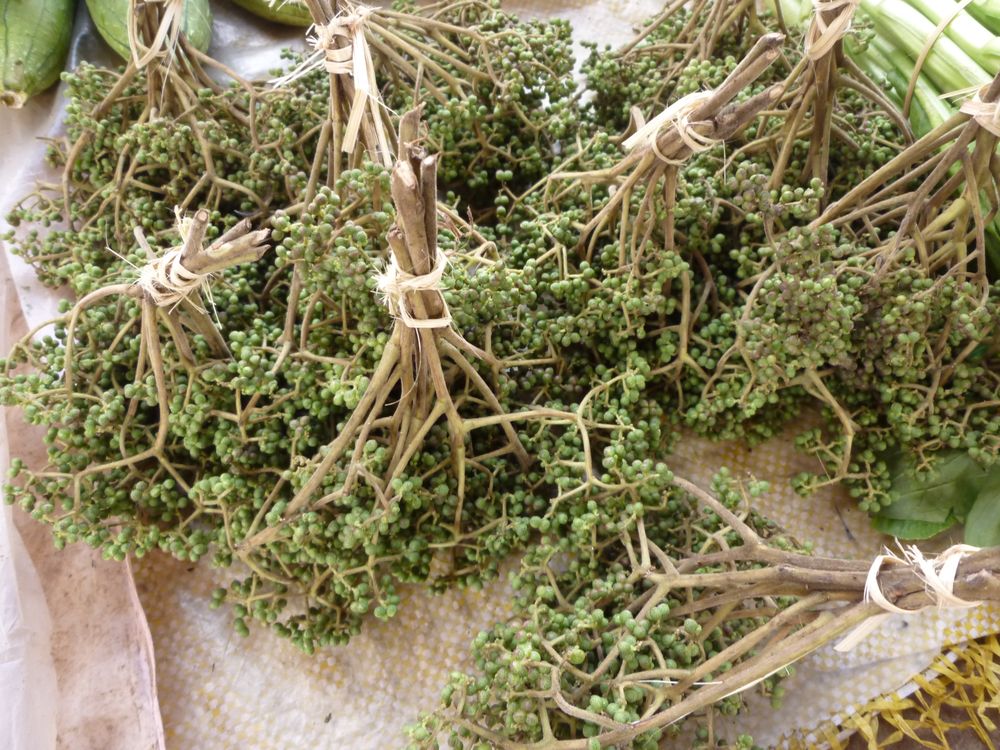
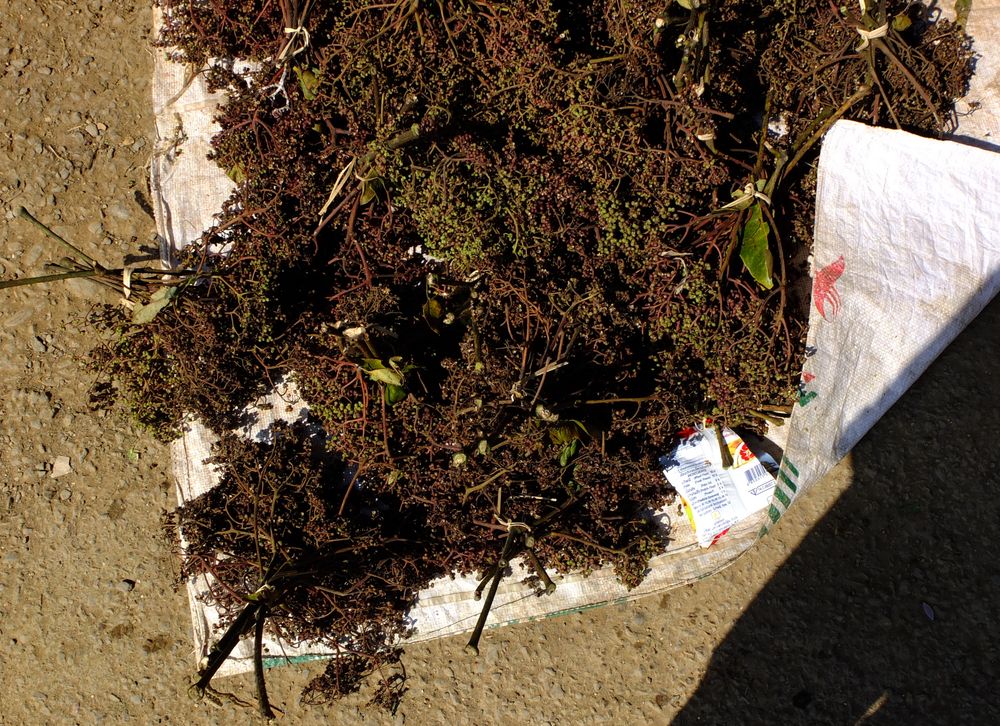
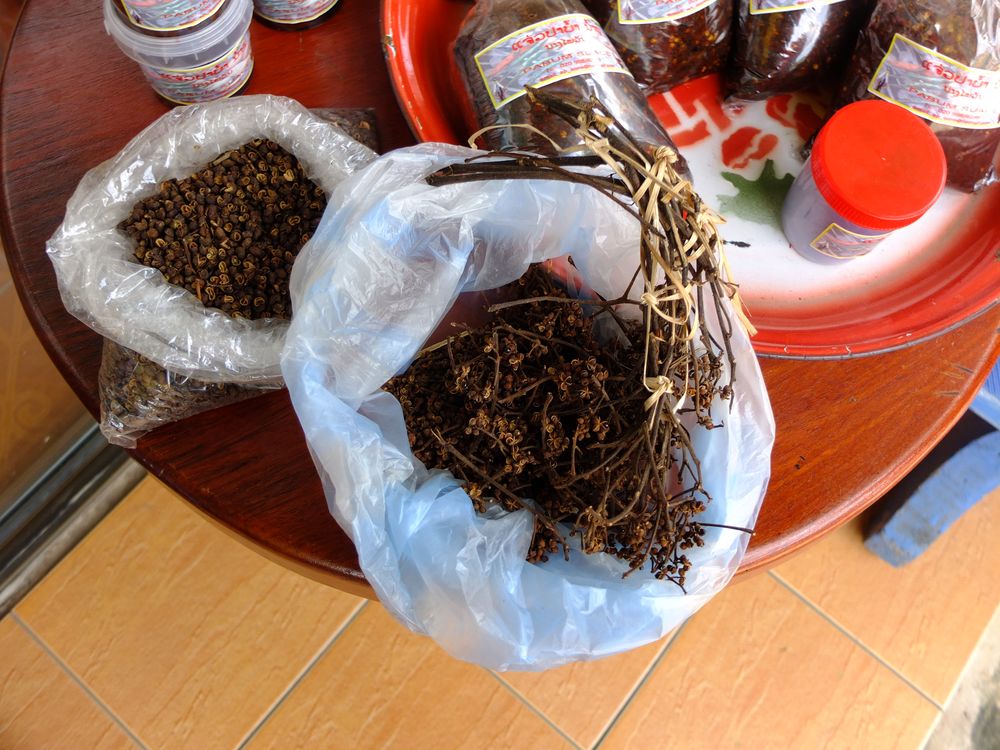
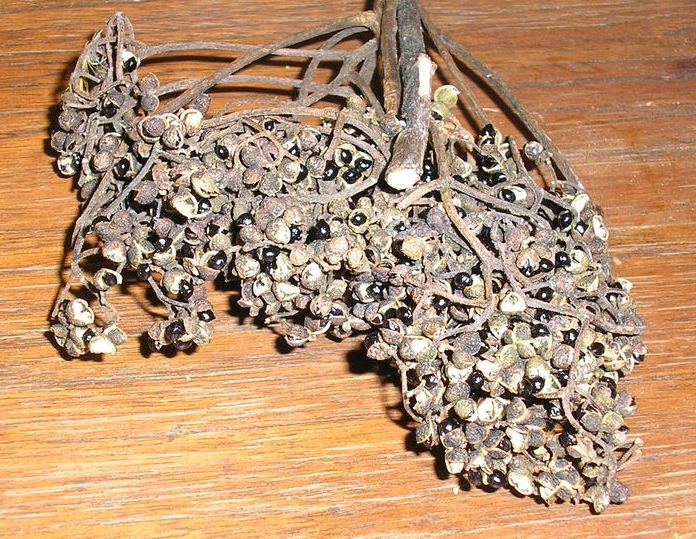
Sichuan pepper is well-known to good chefs and fine gourmets, but what is less known is that in Laos there is a very similar species, which is much sought after, even in China. Both these peppers, of Laos and China, are Zanthoxylum, and belong to the Rutaceae family which comprises a number of highly aromatic plants including the Citrus; the different species of this genre are not always well identified, they are found in the world’s hot climates, and all the Asian species, contrary to those of America and Africa, are used in cooking.
The « Lao pepper », mak khène, strongly resembles its Chinese neighbour and it has all its properties although its taste is a little different. It is found growing wild, but it can also be cultivated. As a spice, it is used less than in the neighbouring region of Yunnan, but its uses are more varied. The fruit pods are crunched and blended with meat or fish; cracked and roasted, they are put in certain spicy sauces. The young leaves are also served as a condiment or vegetable.
In traditional medicine, mak khène has the reputation for treating goitres, but it is also currently used as an oral anaesthetic. Moreover, it is used as an ingredient in certain modern toothpastes. The leaves are among those that enable the making of rice wine. Finally, and for a lengthy period of time, this yellowish wood (that is the meaning of zanthoxylum) continues to be used in the making of tool handles, sword sheaths, and statues.
These diverse uses make mak khène very appreciated by the domestic market and sought after by our neighbours, the Chinese in particular, who import more and more of it. The easy harvesting of this fruit condiment constitutes a considerable supply to the economy of numerous villages in northern Laos. Sadly, this same ease of harvesting is leading to the depletion of this plant in its natural state and its farming is now encouraged by the Lao government.
Le Poivre du Sichuan est bien connu des bons cuisiniers et des fins gourmets, mais ce que l’on sait moins c’est que pousse au Laos une espèce très proche, très recherchée dans la région jusqu’en Chine même. Ces poivres, celui du Laos et celui de Chine, sont des Zanthoxylum, ils appartiennent à la famille des Rutacées qui englobe nombre de plantes très aromatiques dont les Citrus; les différentes espèces de ce genre ne sont pas toujours bien identifiées, elles se retrouvent toutes dans les régions chaudes du Globe et toutes les espèces asiatiques, au contraire des espèces américaines et africaines sont utilisées en cuisine.
« Le poivre du Laos », mak khène, ressemble fort à son voisin chinois et il en a toutes les propriétés avec, toutefois, une saveur un peu différente. On le trouve à l’état sauvage mais il pourrait aussi être cultivé. Comme épice on l’emploie moins que dans la région voisine du Yunnan mais ses utilisations sont plus variées. Les cosses du fruit sont croquées en accompagnement de viande ou de poisson; grillées et pilées on les met dans certaines sauces pimentées. Les jeunes feuilles sont également employées comme condiment ou légume.
En médecine traditionnelle, mak khène a la réputation de soigner le goitre, mais on l’emploie aussi couramment comme anesthésique buccal; d’ailleurs il entre dans la composition de certains dentifrices modernes. Les feuilles font partie des plantes qui permettent la fabrication de l’alcool de riz. Enfin avec le bois jaunâtre (c’est le sens de zanthoxylum) et d’une durée assez longue on fait des manches d’outils, des fourreaux de sabre, des statuettes.
Ces divers usages font que mak khène est très apprécié sur le marché intérieur et recherché par nos voisins en particulier les Chinois qui en importent de plus en plus. La récolte facile de ce fruit-condiment constitue un apport très appréciable à l’économie de nombreux villages du Nord Laos. Malheureusement cette facilité même conduit à la raréfaction de la plante à l’état naturel et sa culture est désormais encouragée par le gouvernement lao.










Sichuan pepper is well-known to good chefs and fine gourmets, but what is less known is that in Laos there is a very similar species, which is much sought after, even in China. Both these peppers, of Laos and China, are Zanthoxylum, and belong to the Rutaceae family which comprises a number of highly aromatic plants including the Citrus; the different species of this genre are not always well identified, they are found in the world’s hot climates, and all the Asian species, contrary to those of America and Africa, are used in cooking.
The « Lao pepper », mak khène, strongly resembles its Chinese neighbour and it has all its properties although its taste is a little different. It is found growing wild, but it can also be cultivated. As a spice, it is used less than in the neighbouring region of Yunnan, but its uses are more varied. The fruit pods are crunched and blended with meat or fish; cracked and roasted, they are put in certain spicy sauces. The young leaves are also served as a condiment or vegetable.
In traditional medicine, mak khène has the reputation for treating goitres, but it is also currently used as an oral anaesthetic. Moreover, it is used as an ingredient in certain modern toothpastes. The leaves are among those that enable the making of rice wine. Finally, and for a lengthy period of time, this yellowish wood (that is the meaning of zanthoxylum) continues to be used in the making of tool handles, sword sheaths, and statues.
These diverse uses make mak khène very appreciated by the domestic market and sought after by our neighbours, the Chinese in particular, who import more and more of it. The easy harvesting of this fruit condiment constitutes a considerable supply to the economy of numerous villages in northern Laos. Sadly, this same ease of harvesting is leading to the depletion of this plant in its natural state and its farming is now encouraged by the Lao government.
Le Poivre du Sichuan est bien connu des bons cuisiniers et des fins gourmets, mais ce que l’on sait moins c’est que pousse au Laos une espèce très proche, très recherchée dans la région jusqu’en Chine même. Ces poivres, celui du Laos et celui de Chine, sont des Zanthoxylum, ils appartiennent à la famille des Rutacées qui englobe nombre de plantes très aromatiques dont les Citrus; les différentes espèces de ce genre ne sont pas toujours bien identifiées, elles se retrouvent toutes dans les régions chaudes du Globe et toutes les espèces asiatiques, au contraire des espèces américaines et africaines sont utilisées en cuisine.
« Le poivre du Laos », mak khène, ressemble fort à son voisin chinois et il en a toutes les propriétés avec, toutefois, une saveur un peu différente. On le trouve à l’état sauvage mais il pourrait aussi être cultivé. Comme épice on l’emploie moins que dans la région voisine du Yunnan mais ses utilisations sont plus variées. Les cosses du fruit sont croquées en accompagnement de viande ou de poisson; grillées et pilées on les met dans certaines sauces pimentées. Les jeunes feuilles sont également employées comme condiment ou légume.
En médecine traditionnelle, mak khène a la réputation de soigner le goitre, mais on l’emploie aussi couramment comme anesthésique buccal; d’ailleurs il entre dans la composition de certains dentifrices modernes. Les feuilles font partie des plantes qui permettent la fabrication de l’alcool de riz. Enfin avec le bois jaunâtre (c’est le sens de zanthoxylum) et d’une durée assez longue on fait des manches d’outils, des fourreaux de sabre, des statuettes.
Ces divers usages font que mak khène est très apprécié sur le marché intérieur et recherché par nos voisins en particulier les Chinois qui en importent de plus en plus. La récolte facile de ce fruit-condiment constitue un apport très appréciable à l’économie de nombreux villages du Nord Laos. Malheureusement cette facilité même conduit à la raréfaction de la plante à l’état naturel et sa culture est désormais encouragée par le gouvernement lao.


